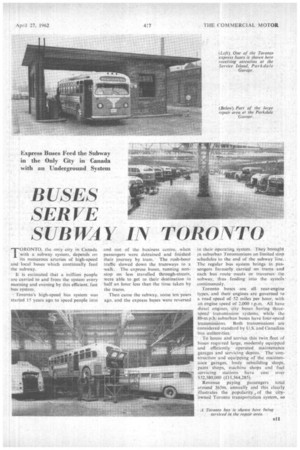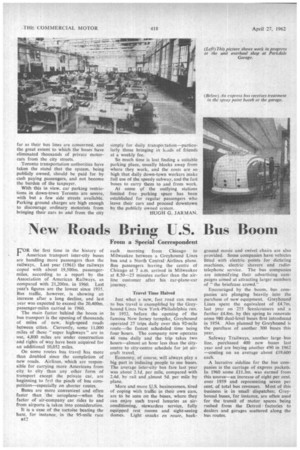BUSES SERVE SUBWAY IN TORONTO
Page 45

Page 46

If you've noticed an error in this article please click here to report it so we can fix it.
TORONTO, the only city in Canada with a subway system, depends on
• its numerous arteries of high-speed and local buses which continually feed the subway.
• It is estimated that a million people are carried to and from the system every morning and evening by this efficient, fast bus system.
Toronto's high-speed bus system was started 15 years ago. to speed people into
and out of the business centre, when passengers were detrained and finished their journey by tram. The rush-hour traffic slowed down the tramways to a walk. The express .buses, running nonstop on less travelled throUgh-streds, were able to get to their destination in half an hour less than the time taken by the trams.
Then came the subway, some ten years ago. and the express buses were reversed
in their operating system. They brought in suburban Torontonians on limited stop schedules to the end of the subway line. The regular bus system brings in passengers formerly, carried on trams and each bus route meets or traverses the subway, thus feeding into the systemn continuously.
Toronto buses are all rear-engine types, and their engines are governed to a road speed of 52 miles per hour, with an engine speed of 2,000 r.p.m. All have diesel engines, city buses having threespeed transmissionsYstems, while the .80-mph. suburban .buSes have four-Speed transmissions. Both transmissions are Considered: standa rd by U.S. and Canadian but authorities.
To house and service this twin fleet of buses .required large, modernly equipped and efficiently operated maintenance garages and servicing depots. The conAtru'ction and equipping of the maintenance garages, body rebuilding shops, paint shoPs,. machine shops and Fuel servicing stations have cost over $32,380,000 (11.1,564,285). '
Revenue paying pastengers lotal around 365m. annually and this clearly illustrates the poptilaritYof the cityowned Toronto transportation System, so far as their bus lines are concerned, and the great extent to which the buses have eliminated thousands of private motorcars from the city streets.
Toronto transportation authorities have taken the stand that the system, being publicly owned, should be paid for by cash paying passengers, and not become the burden of the taxpayer.
With this in view, car parking restrictions in down-town Toronto are severe, with but a few side streets available. Parking ground charges are high enough to discourage ordinary motorists from bringing their cars to and from the city simply for daily transpwtation—particulady those bringing in luads of friends at a weekly fee.
So much time is lost finding a suitable parking place, usually blocks away from where they work, and the costs are so high that daily down-town workers make full use of the speedy subway, and the fast buses to carry them to and from work.
At some of the outlying stations limited free parking space has been established for regular passengers who leave their cars and proceed downtown by the publicly owned system.
HUGH G. JARMAN.




















































































































